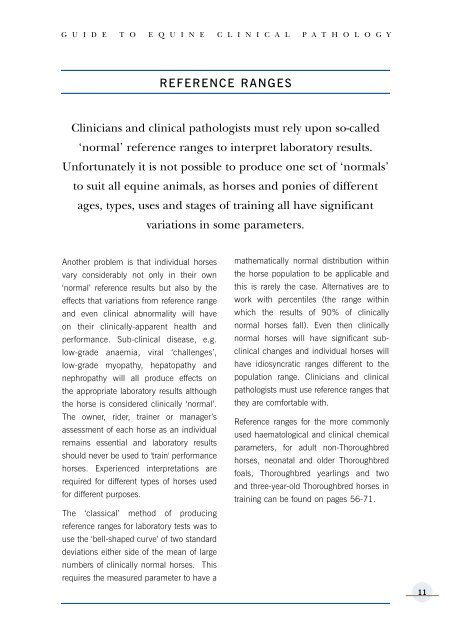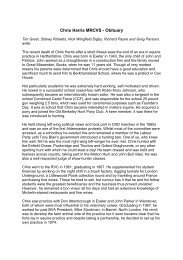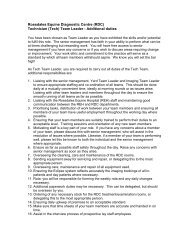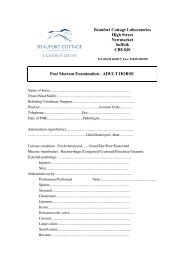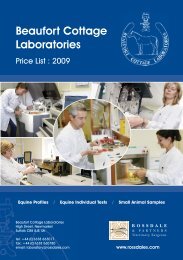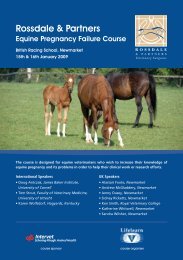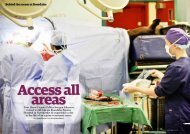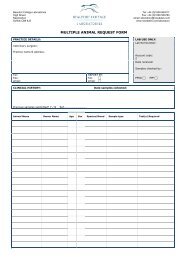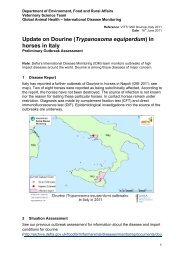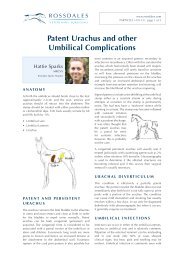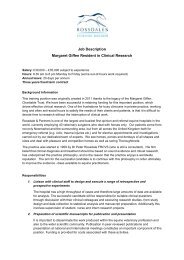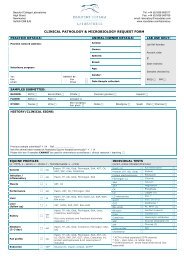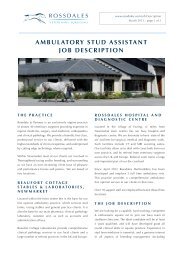EQUINE CLINICAL PATHOLOGY - Rossdale & Partners
EQUINE CLINICAL PATHOLOGY - Rossdale & Partners
EQUINE CLINICAL PATHOLOGY - Rossdale & Partners
You also want an ePaper? Increase the reach of your titles
YUMPU automatically turns print PDFs into web optimized ePapers that Google loves.
G u i d e t o e q u i n e c l i n i c a l p a t h o l o g y<br />
reference ranges<br />
Clinicians and clinical pathologists must rely upon so-called<br />
‘normal’ reference ranges to interpret laboratory results.<br />
Unfortunately it is not possible to produce one set of ‘normals’<br />
to suit all equine animals, as horses and ponies of different<br />
ages, types, uses and stages of training all have significant<br />
variations in some parameters.<br />
Another problem is that individual horses<br />
vary considerably not only in their own<br />
‘normal’ reference results but also by the<br />
effects that variations from reference range<br />
and even clinical abnormality will have<br />
on their clinically-apparent health and<br />
performance. Sub-clinical disease, e.g.<br />
low-grade anaemia, viral ‘challenges’,<br />
low-grade myopathy, hepatopathy and<br />
nephropathy will all produce effects on<br />
the appropriate laboratory results although<br />
the horse is considered clinically ‘normal’.<br />
The owner, rider, trainer or manager’s<br />
assessment of each horse as an individual<br />
remains essential and laboratory results<br />
should never be used to 'train' performance<br />
horses. Experienced interpretations are<br />
required for different types of horses used<br />
for different purposes.<br />
The ‘classical’ method of producing<br />
reference ranges for laboratory tests was to<br />
use the ‘bell-shaped curve’ of two standard<br />
deviations either side of the mean of large<br />
numbers of clinically normal horses. This<br />
requires the measured parameter to have a<br />
mathematically normal distribution within<br />
the horse population to be applicable and<br />
this is rarely the case. Alternatives are to<br />
work with percentiles (the range within<br />
which the results of 90% of clinically<br />
normal horses fall). Even then clinically<br />
normal horses will have significant subclinical<br />
changes and individual horses will<br />
have idiosyncratic ranges different to the<br />
population range. Clinicians and clinical<br />
pathologists must use reference ranges that<br />
they are comfortable with.<br />
Reference ranges for the more commonly<br />
used haematological and clinical chemical<br />
parameters, for adult non-Thoroughbred<br />
horses, neonatal and older Thoroughbred<br />
foals, Thoroughbred yearlings and two<br />
and three-year-old Thoroughbred horses in<br />
training can be found on pages 56-71.<br />
11


